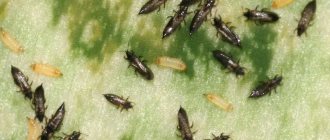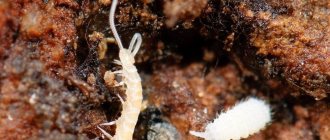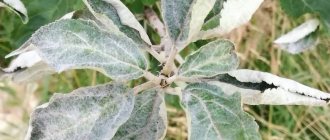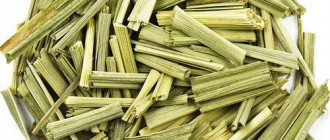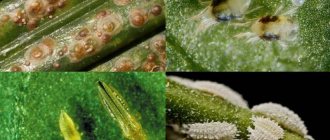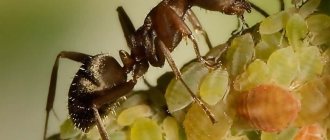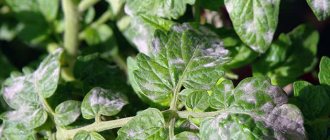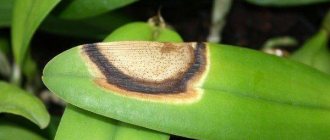Description and appearance
Poduras (or springtails, springtails) are ancient inhabitants of the Earth. These insects have existed for 400 million years. Poduras look like small segmented worms. The body length of adult insects is 0.2-3 mm; there are numerous microscopic bristles on the body.
Soil podurs live in pots with houseplants; they are white or light gray in color. This type of insect does not have wings; it has 3 pairs of legs.
The most interesting organ of these creatures is the furca, or jumping fork, located at the end of the body. At rest, it folds and is fixed on the abdomen. If necessary, the fork can be detached and used for jumping. Such jumps allow insects not to stick to the film of water on the soil surface.
Some researchers believe that jumping is part of the mating “dance” of these insects. It is surprising that with microscopic sizes, springtails can jump to a height of up to 3 cm.
The gnawing type mouthparts are located in the lower part of the head.
They reproduce by eggs, from which hatch larvae that look similar to adults, only smaller in size. After a few molts they reach sexual maturity.
Interesting fact! Until the mid-18th century, springtails were considered worms. Only the naturalist Carl Linnaeus was the first to classify poduras as wingless insects.
Appearance
Entomological classification
As is often the case, when talking about fools, flower growers do not mean real fools, insects of the family Poduridae (Podurids), but their closest relatives - springtails from the families Hypogastruridae and Entomobryidae, subclass Collembola (Collembolas). Collembolas are a order of cryptomaxillary, which includes about 8 thousand species.
Real fools do not live in the soil of indoor plants at all; their habitat is ponds, puddles, and swamps. Their diet consists of simple fungi, mosses, lichens and algae. But the springtails Hypogastruridae and Entomobryidae are our home flower lovers. But, since this is how it is, we will continue to call springtails fools.
Fools - appearance
How can you tell if your flower is full of fools?
Poduras look like small white or cream-colored caterpillars with short antennae. There are specimens painted in a greenish or silvery tint. The size of the insects is approximately 2 mm, in some cases it can reach 1 cm. A special fork is attached to the underside of the abdomen, thanks to which the podras can not only crawl on the soil, but also jump, pushing off the surface with the fork. It is by this feature that an inexperienced gardener can distinguish the dur from other pests, such as mealybugs.
Beginning gardeners confuse podur not only with mealybugs, but also with insects such as fungus gnat larvae or thrips. But although all these insects are white or cream-colored, it is very easy to distinguish springtails by their ability to jump on the surface of the soil.
Podura larvae look approximately the same and differ from adults only in size.
Reasons for the appearance of dupes
Podurs can live on indoor plants unnoticed in small numbers, without showing themselves in any way. They begin to actively reproduce in waterlogged soil. This happens due to:
- excessive, abundant watering (overflow);
- stagnation of moisture in the tray, the lower part of the flowerpot (due to improperly arranged drainage);
- high air humidity, especially in combination with low temperature, large temperature changes during the day;
- excess nitrogen-containing compounds in the soil (excess organic fertilizers);
- clogging of the pot with organic matter (dead, diseased parts of the plant);
- the presence of moss, mold, fungi in the soil.
Why are springtails dangerous for plants and the damage they cause?
The appearance of podura in flowers in small quantities should serve as a signal to gardeners that the plants are being kept in improper conditions. Springtails are herbivorous decomposers, that is, they feed on dead organic matter. At the same time, organic substances decompose into simple chemical compounds, enriching the soil. Their diet at home includes:
- dead above-ground and underground parts of the plant (roots, leaves, etc.);
- moss;
- fungus and mold;
- algae growing on the surface of waterlogged soil.
When there are too many springtails, they may not have enough food, and they begin to eat young shoots and roots of the plant. In conditions of excess humidity this can lead to:
- rotting;
- weakened immunity;
- development of diseases (viral and microbial).
Development of the disease
Signs of infection
It is not difficult to determine that an indoor crop has been affected by a dangerous parasite. This will be highlighted by several symptoms:
If the soil moisture increases significantly, a whitish coating will form on its surface. This is where small insects are kept.- Mature individuals, with a two-millimeter body, lead an active lifestyle, jumping in every possible way and demonstrating their activity.
- The elongated body of podurs can have different colors: from white to brown.
- Small creatures quickly move to the upper parts of the flower, spending much of their time in the surface soil layers. Active reproduction of the colony, deterioration in temperature and moisture levels contribute to the rapid “occupation” of roots and leaves, from which the podurs suck out the nutritious juice.
Currently, scientists identify several main varieties of springtails: white, vegetable, and mushroom. Representatives of the first species eat the top soil layer and often attack greenhouse and greenhouse plants grown in conditions of high moisture. Vegetable pests are a danger to all ornamental plantings that grow indoors. They interfere with the normal formation of green mass and stop their normal development.
As for fungal pests, this species affects young shoots, seedlings of champignons and bulbous flowers.
How to get rid of idiots?
When springtails are detected, quick measures are necessary to prevent their mass reproduction and spread throughout the home greenhouse.
The first step is to transplant the affected plant into fresh soil. The pot and root system need to be disinfected: pour boiling water over the container, dip the roots in a weak solution of potassium permanganate for half an hour.
If poduras are visible only in one pot, this does not mean that they are not in others. It is necessary to carefully monitor the remaining plants in order to notice the spread of pests in time.
Traditional methods
The first way to get rid of springtails in a pot is as follows:
The pot is immersed in a large container of water so that the water covers it completely. The plant is not removed from the soil. Podurs float to the surface and then must be manually collected and destroyed.
Attention! This method will be effective with a small number of pests. Also, during this procedure, light fractions of the substrate float (expanded clay, perlite, peat).
Washing pots and trays with hot water and soap can also be considered a folk control method.
For another method of destroying fools in the soil, you will need raw potatoes. The tuber is cut in half and the halves are placed cut side down on the soil surface. After 2 hours, the potatoes must be lifted, the stuck springtails must be removed (rinsed), and placed back. Repeat the procedure until all pests are collected.
To get rid of annoying insects, the soil in the pot can be dried and deoxidized. To do this, you need to sprinkle a layer of sand and/or sifted wood ash on the surface.
Watering the soil with an infusion of tansy and celandine (2 tablespoons of herb per 1 tablespoon of boiling water) is carried out once a week, at least 4-5 times.
Biological agents
A biological product such as Fitoverm will help fight fools in the soil. The enteric insecticide aversectin is obtained from soil fungi, so it is considered an environmentally friendly method of pest control.
Attention! The packaging of the drug does not indicate that it is intended to combat podurs, however, the experience of flower growers shows that Fitoverm effectively fights these soil inhabitants. To spray one plant and soil in a pot, the solution is prepared at the rate of 2 ml (1 ampoule) per 100 ml of water.
Fitoverm
Chemicals
Chemical pesticides are effective remedies for fungus in the soil.
The following medications will help get rid of pests:
- Bazudin, Pochin, Grom-2 (in powder form) are scattered over the soil surface, mixed with the top layer for better distribution;
- Mospilan is an enteric contact pesticide, the active ingredient is acetamiprid, used for spraying on plants and on the soil surface,
- Aktara (active substance thiamethoxam), Inta-vir (active substance cypermethrin) are systemic insecticides. The concentrate is diluted with water according to the instructions. Water the soil with the solution and spray it onto the plant.
Attention! Treatment with chemicals must be carried out in the absence of children and pets, using personal protective equipment.
Prevention
As mentioned above, high humidity is a necessary condition for the existence of woodlice. Therefore, in order to survive your arthropod neighbors, you will first need to “dry out” the bathroom. Make it a rule to ventilate the room every time after taking water procedures. If this is difficult to do (for example, if you have a large family or an adjoining bathroom), simply leave the bathroom open at night. Don’t be afraid, woodlice will not scatter throughout the apartment - it’s too dry for them. Also try to wipe all surfaces in the bathroom dry once a day.
Carry out a thorough cleaning of the entire bathroom, look into all hard-to-reach places, check for any accumulation of water and dirt.
Pay special attention to the spaces under the bathtub, sink, behind the toilet and washing machine. Treat all hidden corners with cleaner. There is no need to do this cleaning every day, but try to repeat it at least once a month
Next you need to take care of waterproofing. Check all plumbing fixtures and water pipes for leaks and repair them
There is no need to do this cleaning every day, but try to repeat it at least once a month. Next you need to take care of waterproofing. Check all plumbing fixtures and water pipes for leaks and fix them.
A heated towel rail will help dry the air in the bathroom. If it is not warm enough, install a heater and turn it on for a couple of hours a day. It wouldn’t hurt to get a hood for the bathroom.
If, as a result of cleaning, you did not find anything that could attract the attention of wood lice and make them settle in your bathroom forever, they are probably coming to visit you from neighboring apartments. In this case, check all the ventilation openings - are there any holes in the mesh? It's also worth checking the floors and walls - you may find cracks between the tiles or in the walls. If any are found, it will not be difficult to seal them and block the woodlice’s access to your apartment.
If any are found, it will not be difficult to seal them and block the woodlice’s access to your apartment.
In this case, check all the ventilation openings - are there any holes in the mesh? It's also worth checking the floors and walls - you may find cracks between the tiles or in the walls. If any are found, it will not be difficult to seal them and block wood lice’s access to your apartment.
Preventive actions
To prevent podurs from appearing in pots (or from re-inoculating), it is necessary to maintain optimal temperature and humidity parameters. Perhaps this is the main preventive measure.
It is also worth paying attention to the following points:
- It is better to purchase new plants in trusted stores and nurseries;
- the condition of the plants and substrate in pots must be carefully monitored;
- do not overdo it with fertilizing, provide the plants with a period of rest;
- dead parts of plants must be promptly removed and the soil loosened;
- create proper drainage in flower pots, prevent moisture from stagnating in the pot or tray;
- select a pot (plant pot) in accordance with the size of the root system;
- periodically carry out preventive treatments with herbal insecticides and growth stimulants in order to improve plant health and increase resistance to various pests and diseases.

